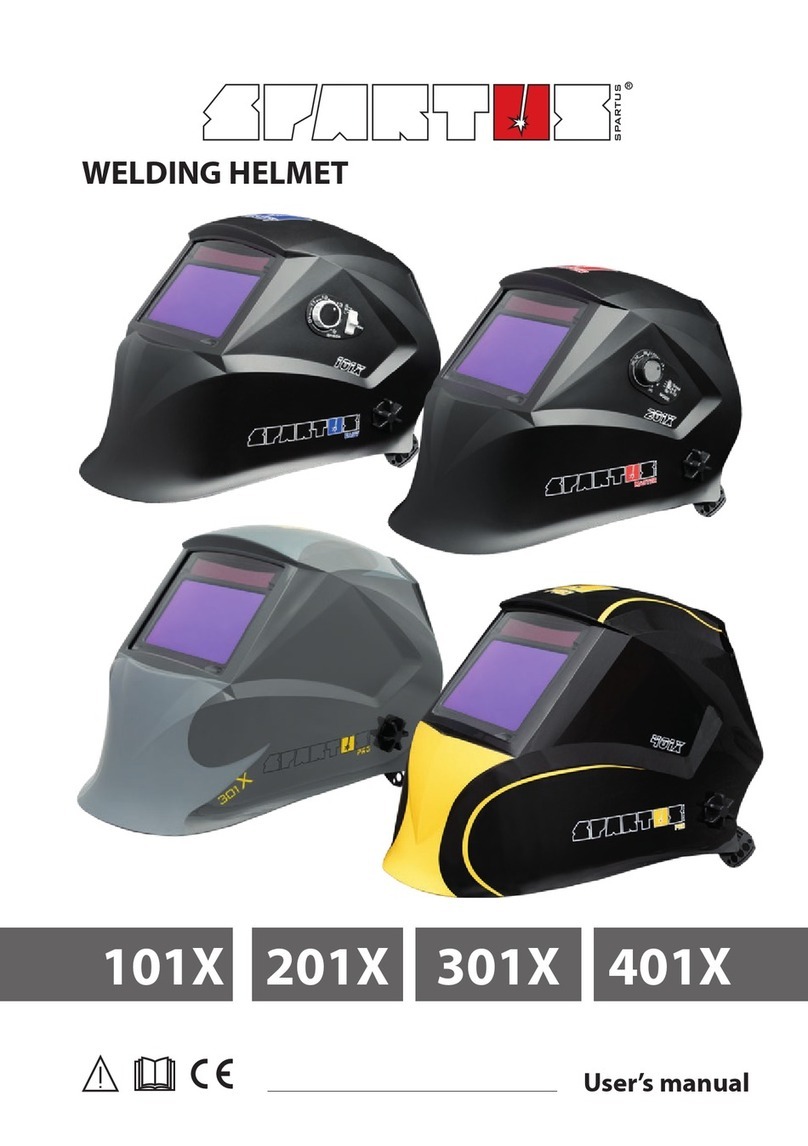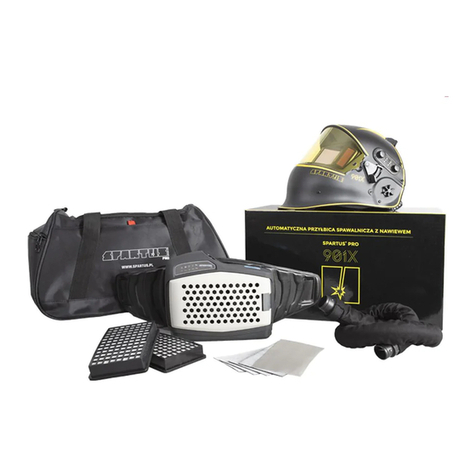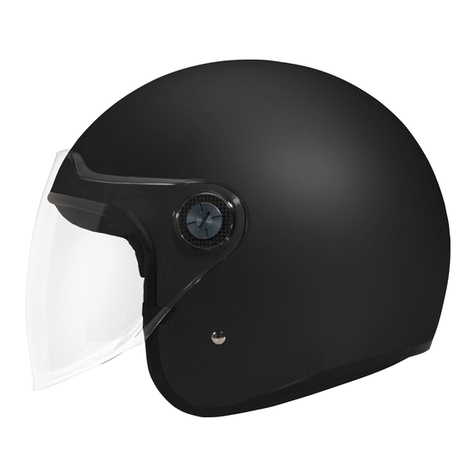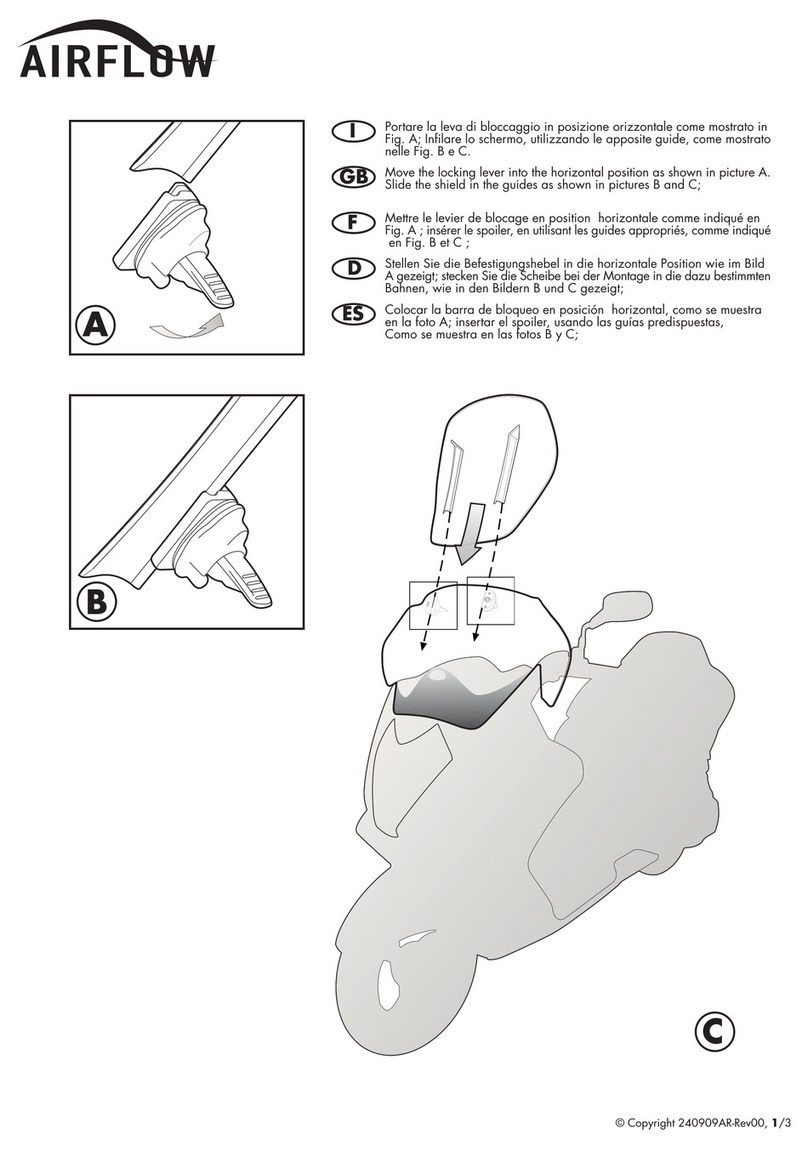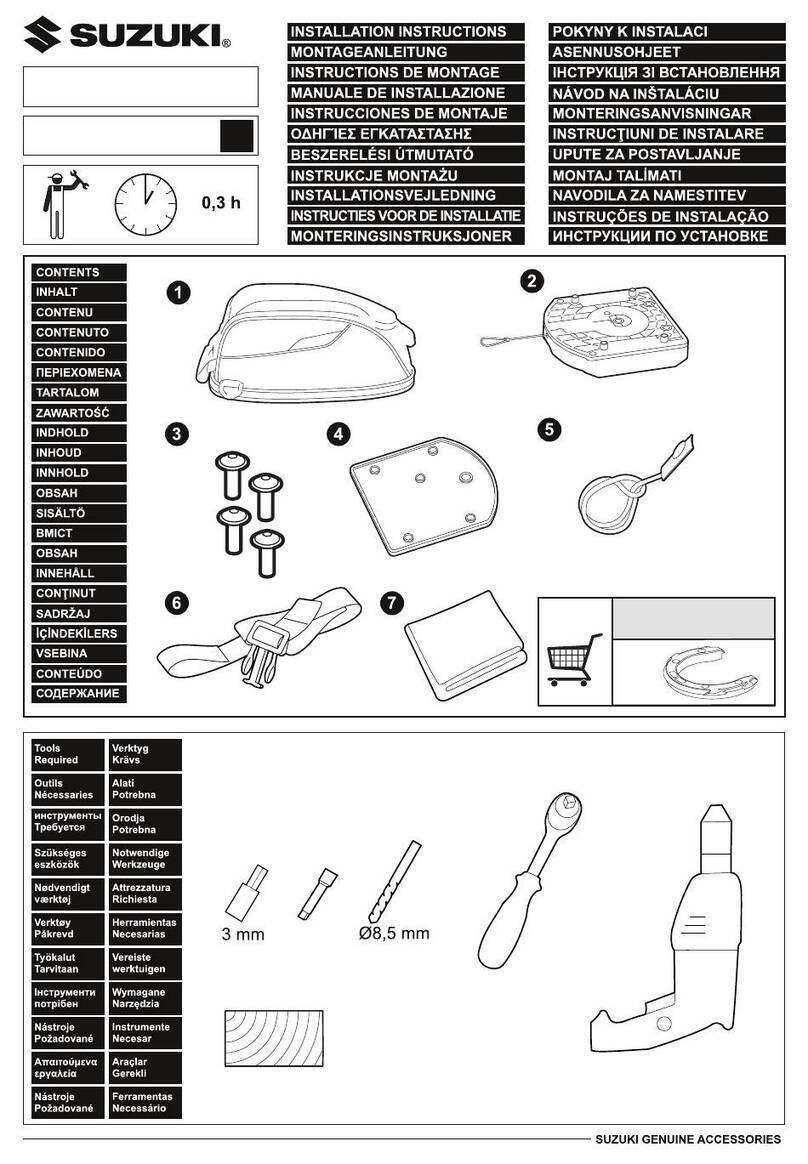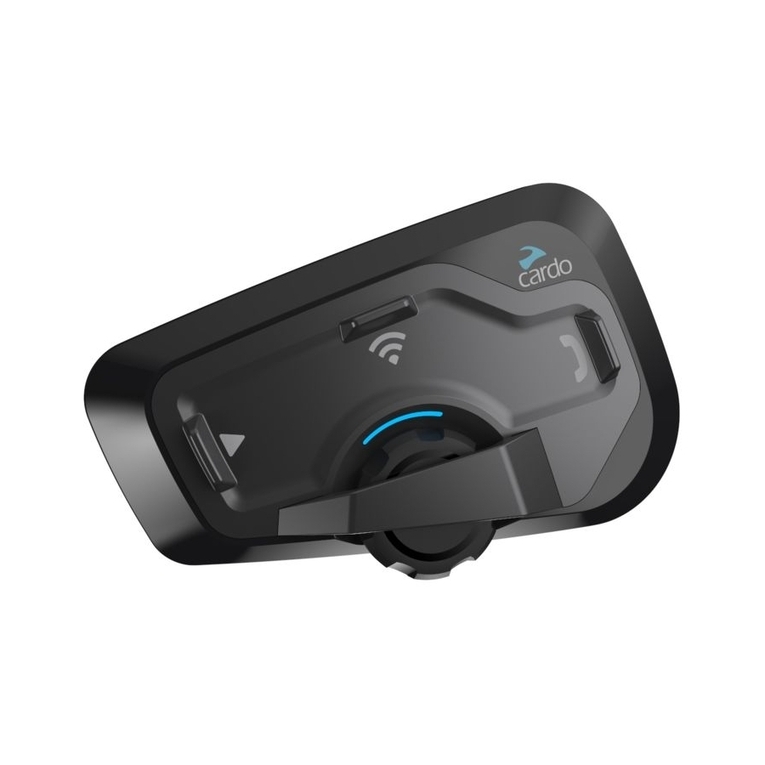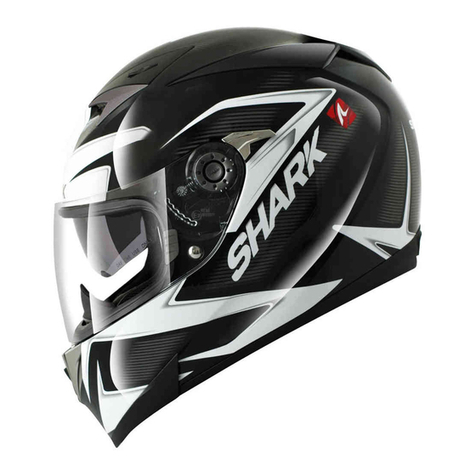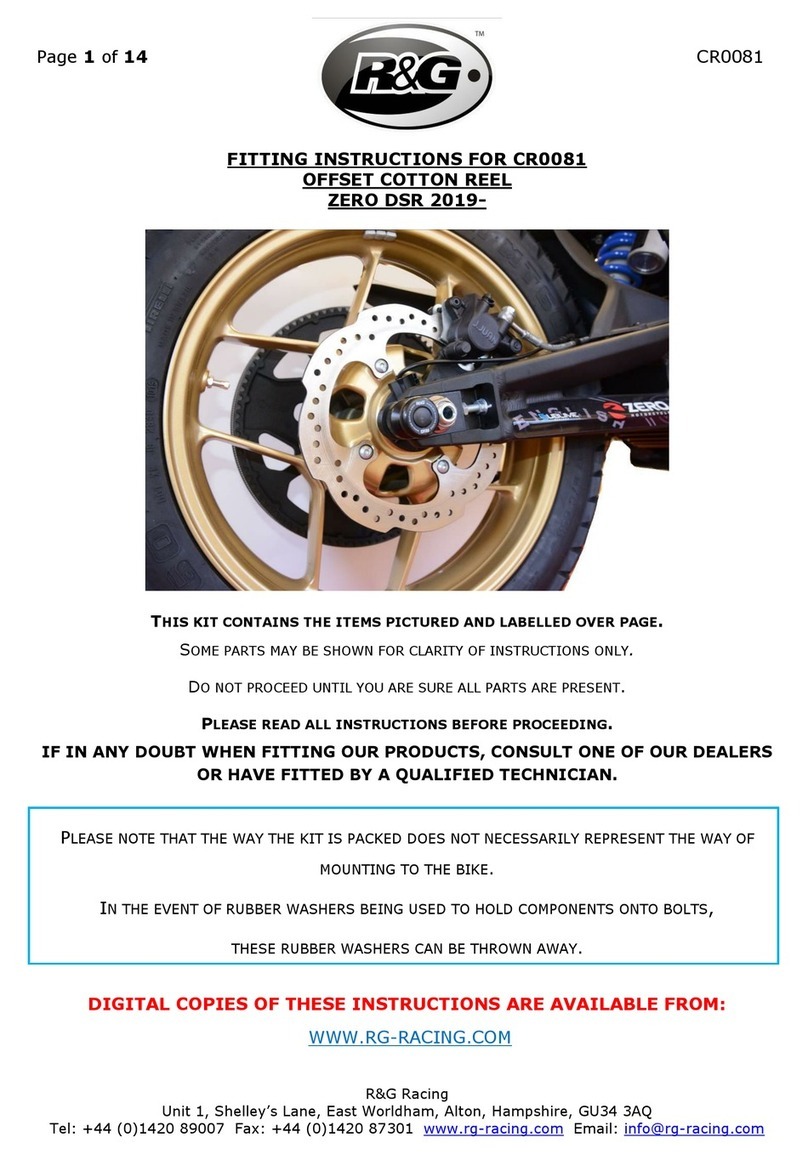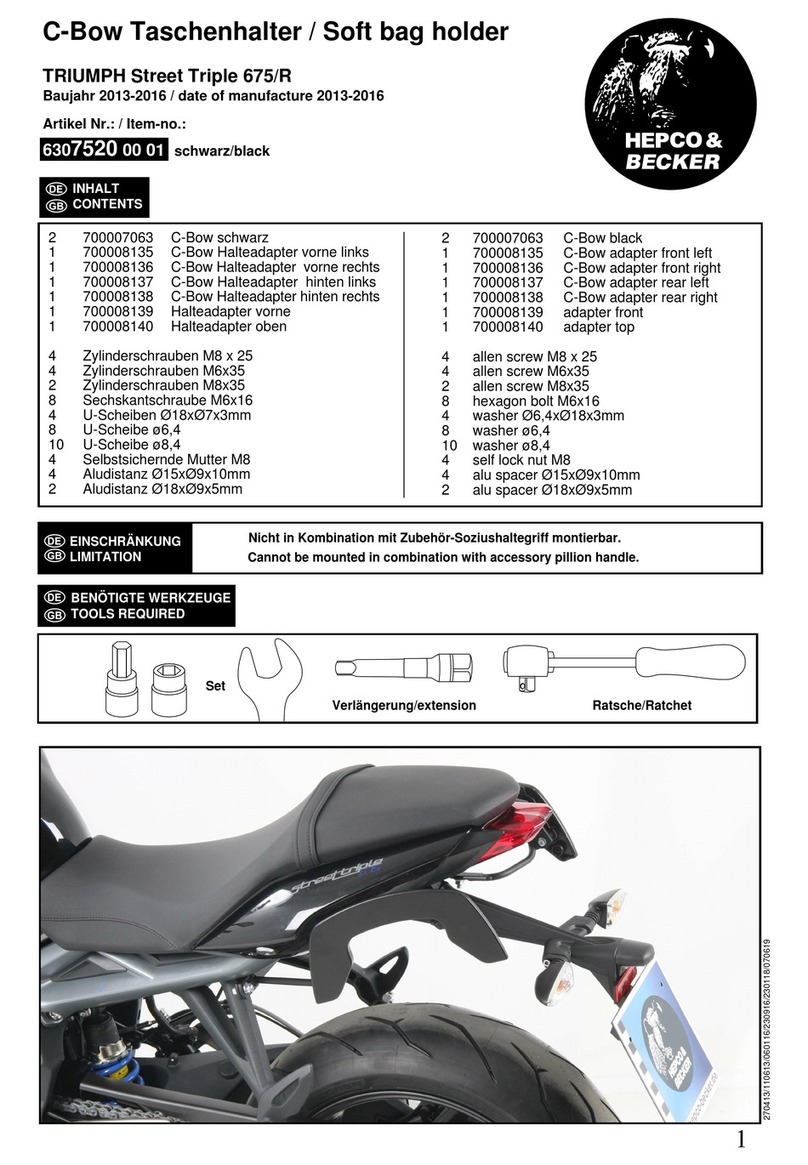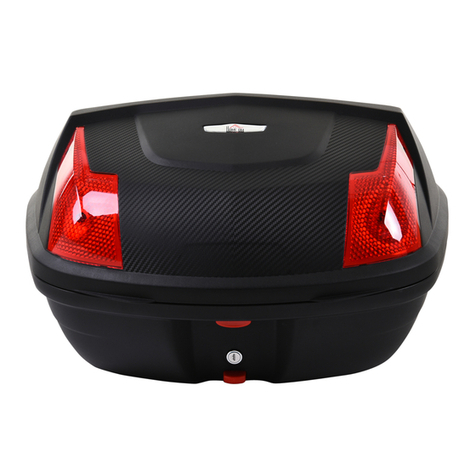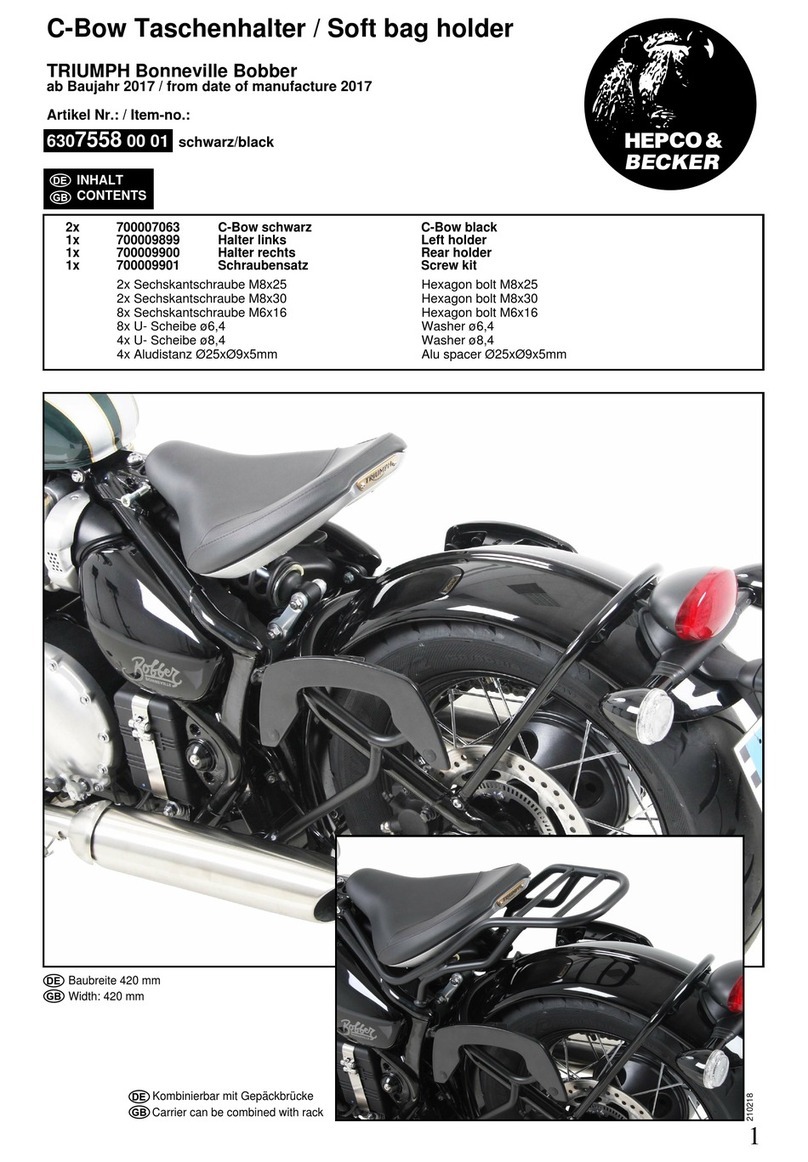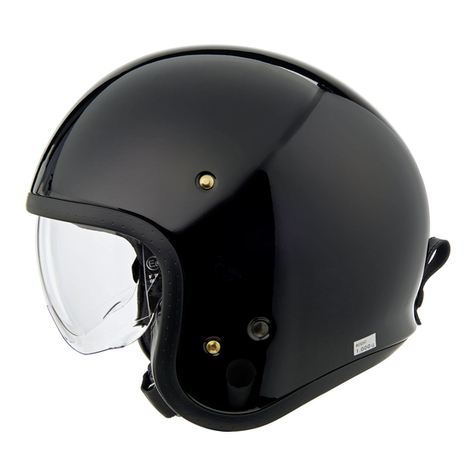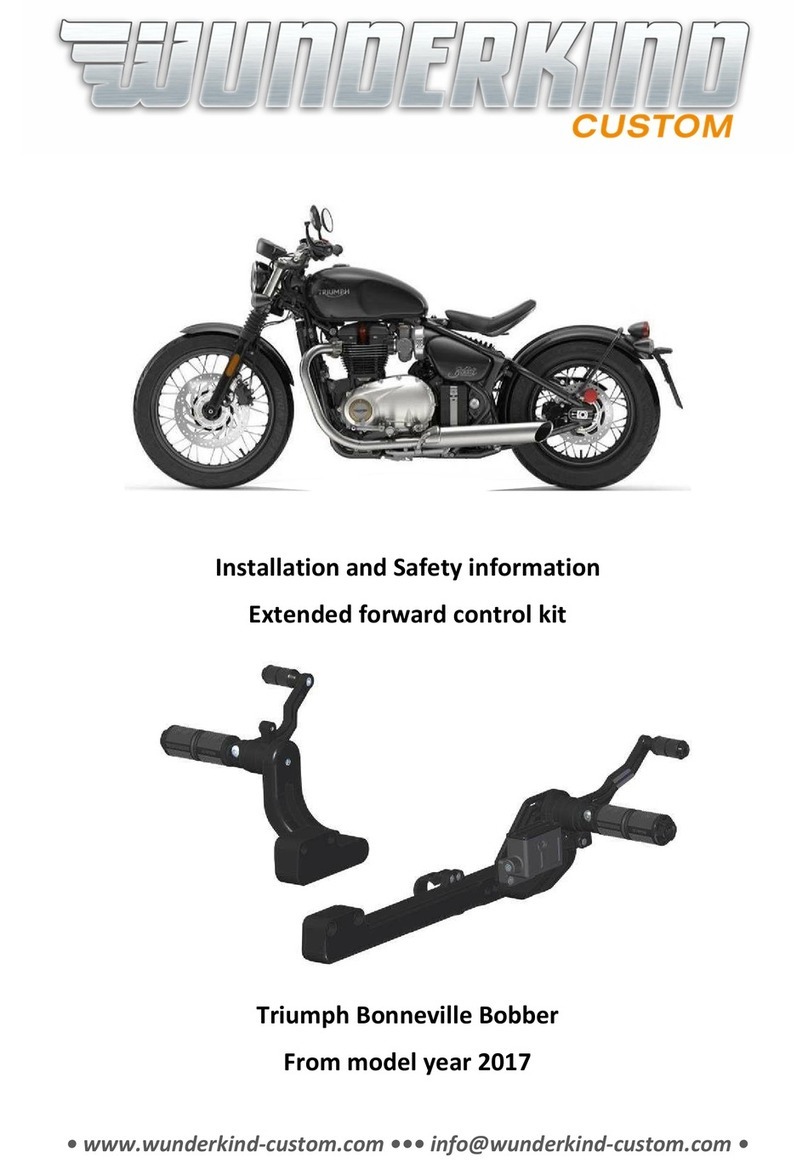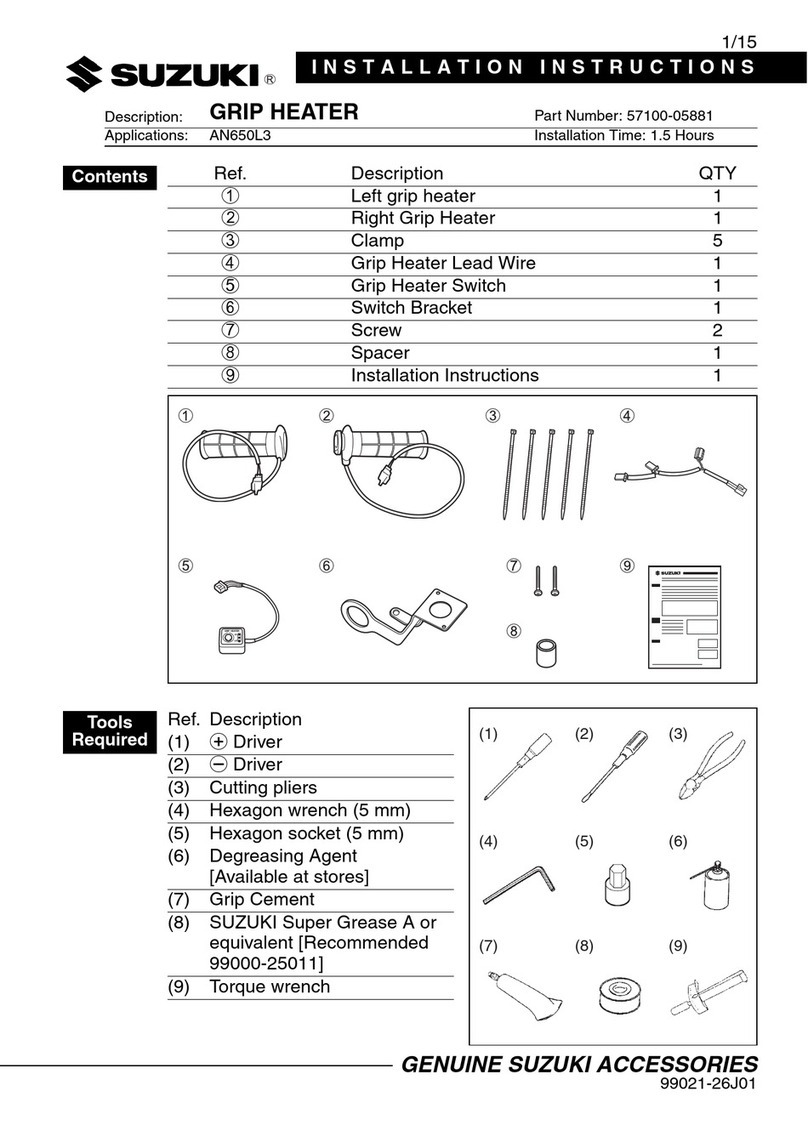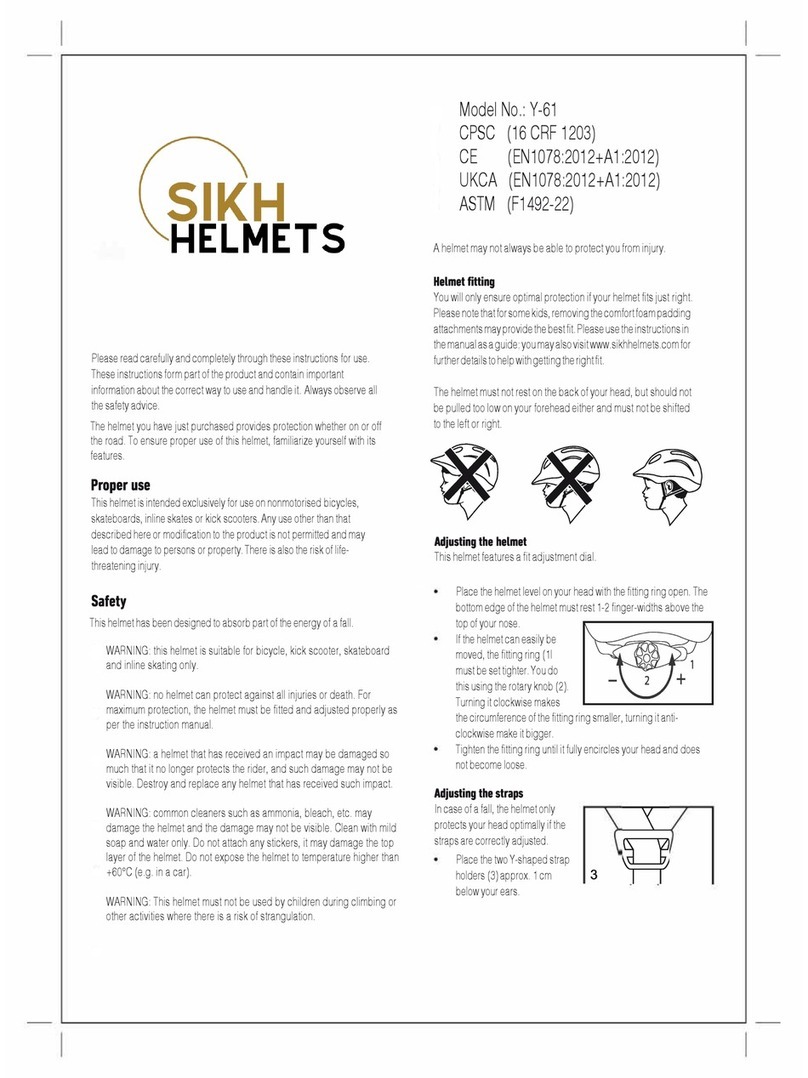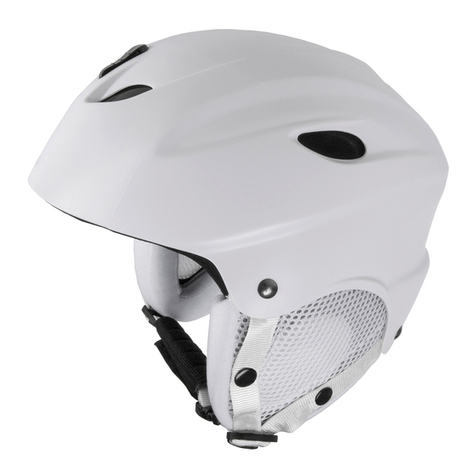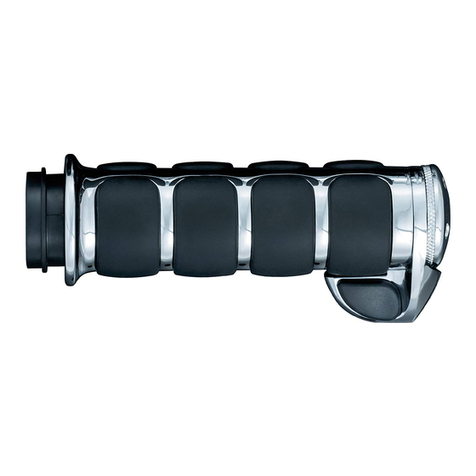Spartus 901X User manual

User’s manual
WELDING HELMET
THE AIR SUPPLY SYSTEM
901X
©
THE AIR SUPPLY

WELDING EQUIPMENT SUITABLE FOR TODAY’S NEEDS
Thank you for purchasing our product!
You have made a right choice. Plasma welding and welding processes are
carried out in difficult conditions that expose welding equipment to extreme
tests of its strength. Only high quality equipment can ensure required reliability
and performance during realization of the above-mentioned processes. SPAR-
TUS® products are characterized by precisely such features: they are primarily
reliable and durable, but they are also versatile.We listen carefully to clients’
needs.Therefore, our offer covers such a wide assortment of products.Thank
you very much for your trust in our company. We would like to invite you to
familiarize yourself with the remaining products and offer at www.spartus.
info or directly at alocal distributor of SPARTUS® products.

Before using this product, read the instruction manual in its entirety, with understanding.
Keep the instructions for quick reference to it if necessary. Pay special attention to safety
instructions provided for your protection. In the event of any points of misunderstanding
instructions, contact your supplier or supervisor.
IMPORTANT!
TABLE OF CONTENTS
1. SAFE USE ....................................................................................................................................................................... 2
1.1 Welding arc radiation can be dangerous ......................................................................................................................... 2
1.2 Symbols used in instructions ................................................................................................................................................ 3
2.
CONFORMITY WITH STANDARDS ........................................................................................................... 3
3.
GENERAL DESCRIPTION ............................................................................................................................. 3
3.1 Purpose of use ............................................................................................................................................................................. 4
4.
TECHNICAL SPECIFICATIONS .................................................................................................................... 4
4.1 Operation, storage and transport ....................................................................................................................................... 4
4.2 Technical parameters of welding helmet ......................................................................................................................... 4
4.3 Used markings ............................................................................................................................................................................ 5
5.
OPERATION AND USE .................................................................................................................................. 6
5.1 Description of construction ................................................................................................................................................... 6
5.2 Using of welding helmet ......................................................................................................................................................... 8
6.
MAINTENANCE ........................................................................................................................................... 11
6.1 Replacing the lters covers .................................................................................................................................................. 11
6.2 Battery changing ...................................................................................................................................................................... 11
6.3 Cleaning instructions ............................................................................................................................................................. 12
7.
LIST OF SPARE PARTS FOR HELMETS .................................................................................................. 12
7.1 Helmet SPARTUS® Pro 901X ................................................................................................................................................. 12
8.
THE AIR SUPPLY SYSTEM FOR HELMET SPARTUS® Pro.................................................................. 13
8.1 General information ................................................................................................................................................................ 13
8.2 Conformity with standards................................................................................................................................................... 13
8.3 Technical specications ......................................................................................................................................................... 14
8.4 Operation and use ................................................................................................................................................................... 14
8.5 Maintenance .............................................................................................................................................................................. 18
8.6 List of spare parts ..................................................................................................................................................................... 18
9.
ENVIRONMENTAL PROTECTION ........................................................................................................... 19
10.
TROUBLESHOOTING ................................................................................................................................. 19

USER’S MANUAL EN
2
1. SAFE USE
Arc welding and plasma cutting are processes that can pose hazards for the operator and persons
in his vicinity. The operator and his close surroundings are exposed, among others, to the risk
of fire, explosion, electric shock, burning, as well as the risk of getting injured by moving parts
of the device.
Once proper safety measures are provided, electric welding and plasma cutting are relatively
safe processes. For this reason, it is crucial to strictly follow the valid OSH principles during
welding operations.
The information provided below does not release the operator from the obligation to follow
the OSH rules that are binding in his plant/workplace.
Only professionally trained and qualified personnel may install, operate, maintain and repair
the device.
For operators and their supervisors training is essential in: the safe use of the equipment; the
processes; the emergency procedures.
1.1 WELDING ARC RADIATION CAN BE DANGEROUS
In order for maximum user safety we would like to remind the rules limiting the risks arising
from radiation emitted by the welding arc.
Spawanie łukowe i cięcie plazmowe to procesy, które mogą stwarzać zagrożenie dla operatora
i osób znajdujących się w pobliżu. Operator i jego najbliższe otoczenie wystawieni są między
innymi na ryzyko zagrożenia pożarem, wybuchem, porażenia prądem, oparzenia, a także
ryzyko poniesienia obrażeń w wyniku kontaktu z częściami ruchomymi urządzenia. Po
zapewnieniu odpowiednich środków ochronnych, spawanie elektryczne i cięcie plazmowe
to procesy stosunkowo bezpieczne. Z uwagi na to, kluczowe podczas przeprowadzania prac
spawalniczych jest bezwzględne stosowanie się do panujących zasad BHP. Poniższe informacje,
nie zwalniają operatora z obowiązku przestrzegania zasad BHP obowiązujących w zakładzie
Przy wykonywaniu prac spawalniczych, należy stosować się również do wymagań BHP
zawartych w aktualnych wersjach aktów prawnych, do których należą między innymi:
• Rozporządzenie Ministra Infrastruktury z dnia 6 lutego 2003 r. w sprawie bezpieczeństwa
i higieny pracy podczas wykonywania robót budowlanych (Dz. U. 2003, Nr 47, poz. 401) -
Rozdział 16
• Rozporządzenie Ministra Gospodarki z dnia 27 kwietnia 2000 r. w sprawie bezpieczeństwa i
higieny pracy przy pracach spawalniczych. (Dz. U. z 2000 r. Nr 40, poz. 470)
• Rozporządzenie Ministra Gospodarki, Pracy i Polityki Społecznej z dnia 23 grudnia 2003 w
sprawie bezpieczeństwa i higieny pracy przy produkcji i magazynowaniu gazów, napełnianiu
zbiorników gazami oraz używaniu i magazynowaniu karbidu (Dz. U. 2004 nr 7 poz. 59)
• Rozporządzenie Ministra Spraw Wewnętrznych i Administracji z dnia 7 czerwca 2010 r. w
sprawie ochrony przeciwpożarowej budynków, innych obiektów budowlanych i terenów (Dz.
U. 2010 nr 109 poz. 719)
• oraz wszelkich nowych rozporządzeń.
Tylko profesjonalnie przeszkolony i wykwalikowany personel może zainstalować, obsługiwać,
konserwować i naprawiać urządzenie. Dla operatorów (użytkowników) i ich przełożonych
niezbędne jest posiadanie odpowiednich szkoleń i kwalikacji: z zakresu bezpiecznego
użytkowania sprzętu; nt. prowadzonych procesów; nt. procedur awaryjnych.
1.1. PROMIENIOWANIE ŁUKU MOŻE BYĆ NIEBEZPIECZNE
W trosce o jak największe bezpieczeństwo użytkowników, przypominamy zasady ograniczenia
zagrożeń wynikających z emitowanego promieniowania przez łuk spawalniczy.
Łuk spawalniczy generuje:
• Promieniowanie ultraoletowe (może uszkodzić skórę i oczy)
• Światło widzialne (może oślepić oczy i upośledzić widzenie)
• Promieniowanie podczerwone (może uszkodzić skórę i oczy)
Promieniowanie łuku spawalniczego może oddziaływać bezpośrednio lub być
odbite od gładkich powierzchni metalowych lub kolorowych przedmiotów.
1. BEZPIECZEŃSTWO UŻYTKOWANIA
3
INSTRUKCJA OBSŁUGI * PRZYŁBICA SPARTUS
PL
The arc generates:
• ultraviolet radiation (can damage skin and eyes),
• visible light (can dazzle eyes and impair vision),
• infrared (heat) radiation (can damage skin and eyes).
Such radiation can be direct or reflected from surfaces such as bright metals and light
coloured objects.
1.1.1 Eye and face protection
• Use welder’s helmet/shield with an appropriate filter to protect you face and eyes against
sparks and welding arc radiation.
• Welding helmet/shield should prevent injuries from flying particles, e.g. slag, fragments
from grinding or wire bristles, etc.
• Welding helmet/shield should be made in accordance with applicable standards.
1.1.2. Body protection
• The body should be protected by suitable clothing in accordance
with applicable standards.
• Use appropriate protective clothing made of durable and fire-resistant material,
to ensure proper skin protection.
• The use of neck protection can be necessary against reflected radiation.

USER’S MANUAL
EN
3
1.1.3. Protection of persons in the vicinity of an arc
• Protect the remaining personnel present in the vicinity of welding works against negative
impact of arc radiation and welding splatters. Warn them about the hazard resulting from
exposure to the welding arc.
• In the vicinity of an arc, non-reflective curtains or screens should be used to isolate
persons from the arc radiation. A warning, e.g. a symbol for eye protection, should refer
to the hazard of arc optical radiation.
• Welder’s assistants should also wear appropriate protective clothing.
1.2. SYMBOLS USED IN INSTRUCTIONS
We use those symbols to pay your attention about important informations.
2. CONFORMITY WITH STANDARDS
The SPARTUS® welding helmet is in conformity with the relevant Union harmonization legislation:
Directive 2016/425/UE PPE Personal protective equipment
and that the following harmonized standards applied:
EN 175 Personal protection. Equipment for eye and face protection
during welding and allied processes
EN 379 Personal eye-protection. Automatic welding filters
CE marking was placed on the product.
3. GENERAL DESCRIPTION
SPARTUS® Pro 901X helmet has been designed to protect welder’s eyes and face against the
harmful radiation and weld spatters during welding: TIG, MIG/MAG, MMA. Additionally device
has a function of grinding.
SPARTUS® helmet is equipped with automatic welding filter with manual protection level
adjustment of the highest optical class 1/1/1/1 and big, active field of vision 100 x 65mm,
which ensures perfect visibility. Built-in 4 sensors ensures maximum filter sensitivity. Filter includes
possibility of regulation: filter darkening grade, time of filter brightening, filter sensitivity and
TEST function.
Welding helmet has a welding filter lifting module. This increases the field of view to 165 x
72mm, while maintaining eye protection through the outer protective glass.
SPARTUS® Pro 901X welding helmets with air supply system provides clean and dry air to the
welder in particularly difficult conditions, with high levels of dust and humidity.
A high level of respiratory protection TH3P is provided by a set of replaceable filters (main HEPA,
active carbon pre-filter). The whole is protected by a spark shield. The air supply enables variable
adjustment of the airflow speed. The breathing hose is connected to the helmet headgear. This
ensures comfort and convenience of movement while working.

USER’S MANUAL EN
4
3.1 PURPOSE OF USE
Automatic welding helmets SPARTUS® Pro 901X are designed to protect the face and eyes of
the welder, against sparks and welding spatter and against harmful radiation which arises under
normal conditions when:
• GMAW gas metal arc welding (MIG/MAG)
• Tungsten inert gas welding (TIG)
• Manual metal arc welding (MMA) (SMAW – shielded metal arc welding)
SPARTUS welding helmet can be also used to protect face and eyes during grinding elements
made of metal.
It is forbidden to use the helmet SPARTUS®for eye and face protection during welding
and gas cutting, welding and laser cutting. The welding helmet does not protect against
explosive devices or corrosive liquids. It is forbidden to use misused.
4. TECHNICAL SPECIFICATIONS
4.1 OPERATION, STORAGE AND TRANSPORT
Conditions during operation, storage and transport
Range of ambient air temperature during operation from -5°C to +50°C
Range of ambient air temperature during storage and transport from -20°C to +70°C
Store and transport packaging protects against mechanical damage to the helmet.
Do not store or transport, when external and internal covers are taken off.
4.2 TECHNICAL PARAMETERS OF WELDING HELMET
SPARTUS®Pro 901X
Application arc welding: MMA, TIG, MIG/MAG and grinding
WELDING FILTER PARAMETERS
Type of welding filter automatic with manual adjustment degree of protection
Number of sensors 4
Active field of view lowered filter: 100 x 65mm
raised filter: 162 x 72mm
Filter size 122 x 125 x 9mm
Shading (standby) DIN 4
Variable welding shades (operating) DIN 4 - 8 or DIN 9 - 13
UV/IR protection degree to DIN 16
Light to dark switching time 1/20 000s
Delay control light
to dark switching time 0.2s - 1.0s
Sensitivity infinitely adjustable

USER’S MANUAL
EN
5
Power supply solar cells and lithium battery
Optical class 1
Diffusion of light class 1
Variations in Luminous
transmittance class 1
Angle dependency class 1
Test function
Grinding mode
OTHER
Helmet shell material poliamid (PA, Nylon)
Mechanical resistance F wg. EN 175
Headgear adjustable
Weight 540g
Adjustment knob and switch outside
4.3 USED MARKINGS
4.3.1 Welding filter SPARTUS® Pro 901X
Oznaczenie filtra: 4/4-8/9-13 ART 1/1/1/1 EN 379
4 Light shade
/4 The lightest shade (range I)
-8 The darkest shade (range I)
/9 The lightest shade (range II)
-13 The darkest shade (range II)
ART Identication
1 Optical class
/1 Diusion of light class
/1 Variations in Luminous transmittance class
/1 Angle dependency class
EN 379 Number of standard
4.3.2 Helmet shell SPARTUS®
Marking: EN 175 F
EN 175 Number of standard
F Mechanical resistance: medium Energy impact
The helmets reach the optimal parameters at a temperature of 15-25°C (RT).

USER’S MANUAL EN
6
5. OPERATION AND USE
WARNING!
SPARTUS®welding helmet is intended for professional and industrial applications. Installation
and use of the device may only be carried out appropriately trained professionals.
Qualified person (def.)
A person who has gained the relevant technical education, training took place and / or gained
experience to perceive the risk and avoid hazards during use of the product (IEC 60204-1). (IEC 60204-1).
5.1 DESCRIPTION OF CONSTRUCTION
WARNING!
It is forbidden to make any unauthorized modifications to the welding filter and / or other
components of a SPARTUS® welding helmet.
5.1.1 Automatic welding filter
SPARTUS®Pro 901X
7
1
2
3
5
6
4
1Welding/grinding switch
2Shade adjustment knob
3Delay time adjustment knob
4Sensitivity adjustment knob
5Test button
6Battery socket CR2450 3V
7Inner polycarbonate lter shield

USER’S MANUAL
EN
7
5.1.2 Welding helmet SPARTUS®
8Welding helmet shell
9Outer polycarbonate lter shield
10 Screw nuts (headgear)
5.1.3 Headband of SPARTUS® Pro 901X helmet
11 Sweatband (cloth)
12 Headband top pad
13 Front headband
14 Headband back pad
15 Headband regulator assembly
19
18
17
16
14
15
20
12 13
11
16 Left band & right band
17 Angle adjusting shim (left/right)
18 Headband xing screw (left/right)
19 Headband rack (left/right)
20 Adjusting the distance of the visor
8
9
10

USER’S MANUAL EN
8
5.2 USING OF SPARTUS® WELDING HELMET
WARNING!
Scratched or damaged protection shields (inner and outer) have to be replaced for the
new one. Optical sensors must be kept clean. Remember to do not cover them.
Before first use
(or first use after a short break at work) of welding helmet you should check its technical
conditionand operationofthewelding filterbyusing the„TEST” button
5
.NextYou should
checkthatthe shadingdegree
2
iscorrect toworkcarriedoutand thecorrespondingmode
is enabled operation
1
. It is forbidden to weld, when theswitch
1
is in „GRIND”position.
5.2.1 Working principle (concerns welding filter)
Automatic welding filter switches automatically from light state to dark state upon the welding
arc ignition. In light mode the protection degree equals DIN 3.5. The protection degree in dark
mode (when exposed to welding arc) equals DIN 4 to DIN 8 or DIN 9 to DIN 13. DIN value in
dark mode could be selected manually by the welder. Switching from dark state to light state
becomes after welding arc expires.
5.2.2 Selecting and adjusting the protection degree
To select and adjust shade number you should use the knob
2
. The user can choose between
values DIN 4 to DIN 8 or DIN 9 to DIN 13, depending on the selected knob 1position :
a) 4 – 8
b) 9 – 13
12

USER’S MANUAL
EN
9
RECOMMENDED SHADING
* prepared by SPARTUS®according to EN 379
** term „heavy metals“ applies to steel, steel alloys, copper, copper alloys, etc.
Current [A]
1,5 6 10 15 30 40 60 70 100 125 150 175 200 225 250 300 350 400 450 500 600
Level of security* for the process:
MMA 8 9 10 11 12 13 14
MAG 8 9 10 11 12 13
14
TIG 8 9 10 11 12 13 14
MIG
heavy metals** 9 10 11 12 13 14
MIG
light alloys 10 11 12 13 14
electroerosion 10 11 12 13 14 15
plasma cutting 9 10 11 12 13
microplasma
welding 4 5 6 7 8 9 10 11 12
1,5 6 10 15 30 40 60 70 100 125 150 175 200 225 250 300 350 400 450 500 600

USER’S MANUAL EN
10
5.2.3 Sensitivity and delay adjustment
The sensitivity of the filter is responsible for the welding filter response to changes in light.
Before each use, set its value to the maximum. In the sunny rooms or when are multiple light
sources may be necessary to reduce the sensitivity of the filter.
The highest sensitivity: knob 4SENSITIVITY: HIGH.
Delay time is to which when filter passes from the dark state to the light state DIN 4. It is
recommended to set this value to maximum.
The maximum delay time: knob 2DELAY: LONG.
5.2.4 Adjusting headgear
Too loose headgear can cause an excessive down slope of the welding helmet. When headgear
is too tight can cause excessive pressure on head and consequently causes to discomfort. To
adjust the right size of headband (loose or tighten) use the adjustment knob 15 .
The headgear should not fall too much on the operator’s face. The helmet depth is adjusted
using the top strap 12 .
5.2.5 Adjusting the distance between face and helmet
If the distance between the welder’s face and the helmet body is too small, change the distance
settings. Headgear has 3 levels of distance regulation. To set right distance from the face use
the mechanizm
20
.Release pin and set the right distance level. Remember that it has to be
simetrical regulated on both sides of headgear.
5.2.6 Incline angle adjustment
An inappropriate angle of inclination may cause discomfort during
operation or cause the visor to move over the head of the operator
when tilting the head.
Incline angle adjustment can be made by using angle adjusting
shim 17 in to both sides.
5.2.7 Automatic welding filter lifting system
SPARTUS® Pro 901X helmet has been
designed and equipped with a special
mechanism for raising and lowering the
welding filter. When lifted, the helmet’s
center of gravity is lower and coincides
with the head’s center ofgravity. This
reduces the welder’s neck tiredness
and significantly increases his comfort
of work. The field of view also increases
– 165x72mm, and the welder’s eyes are
protected by aprotective glass.
Warning! The lever should be adjusted
simultaneously with two hands – up (when
lifting) and down (when lowering).

USER’S MANUAL
EN
11
5.2.8 Turning on the grind mode
SPARTUS®Pro 901X helmets have a grinding function. When grinding please choose the switch
1into GRIND position.
In SPARTUS® Pro 901X model it is also possible to lift the automatic welding filter with special
levers. We get a larger field of view – 165x72mm, while maintaining eye protection through an
external protective glass.
6. MAINTENANCE
Maintenance and repair work may be performed only by qualified personnel with the appropriate
permissions. Regular maintenance provides adequate service life and trouble-free operation of the
welding helmet.
Daily: (before use/installation):
• Perform visual inspection of the helmet, knobs, welding filter.
• Check for proper operation of welding filter using TEST button 5.
• Visually inspect the technical condition of the outer guard and the inner guard. Worn or
damaged covers should be replaced by a new one.
• Visually inspect the technical condition of the optical sensors.
At least once a month:
• Visually inspect the sweatband. When worn replace by a new one.
Once a year:
• You should send welding helmet to an authorized service center for an interim review.
• Replace the battery that powers the welding filter.
6.1 REPLACING THE FILTERS COVERS
Regular replacement of the filter welding shield is needed to do the correct operation of the
helmet. Excessively worn or damaged filter covers must be replaced by a new one.
6.1.1 Replacing outer filter cover
SPARTUS®Pro 901X
Krok 1: Unlock the latch on both sides of the glass.
Krok 2: Remove the used protective glass.
Krok 3: Install a brand new protective glass by pushing it into the appropriate latches
on both sides of the helmet.
6.1.2 Replacing inner filter cover SPARTUS® Pro 901X
Step 1: Loosen the screws on the handle filter cover x, zand unlock
the mounting bracket.
Step 2: Replace protective plate for the new one.
Step 3: Place the mounting cover and tighten screws.
6.2 CHANGING BATTERY IN THE HELMET
Use lithium batteries CR2450 3V.
x
z

USER’S MANUAL EN
12
AHelmet shell
BAuto darkening lter
CComplete headband
DHeadband knob
A
E
D
D
B
G
F
C
EFront cover lens
FInside cover lens
GExternal lter adjustment
6.3 CLEANING INSTRUCTIONS
Clean the welding filter and protection/cover plates with lint-free tissue or
cloth. Do not immerse in water or spray directly with liquids.
7. LIST OF SPARE PARTS OF HELMETS
WARNING!
Use only original parts of the helmet, supplied by an authorized retailer or an authorized service.
Unauthorized modifications and spare parts can expose the user to the risk of injury.
7.1 SPARTUS® Pro 901X HELMET

USER’S MANUAL
EN
13
8. THE AIR SUPPLY SYSTEM FOR HELMETS SPARTUS® Pro
8.1 GENERAL INFORMATION
SPARTUS® The Air Supply System is intended to protect the respiratory tract of the welder during
his work. The Air Supply System is delivered in a complete set, ready to use, which includes:
• SPARTUS® Pro 901X automatic welding helmet
• the air supply
• air hose with protective sleeve
• spark shield
• HEPA main filter
• active carbon pre-filter
• shoulder straps
• lithium-ion battery
• charger with replaceable tips
• bag
8.2 CONFORMITY WITH STANDARDS
The SPARTUS® Air Supply System with helmet is intended for the protection of the respiratory
tract as well as eyes and face. It is in conformity with the relevant Union harmonization legislation:
Directive 2016/425/UE PPE Personal protective equipment
and that the following harmonized standards applied:
IEC 175 Personal protection – Equipment for eye and face protection
during welding and allied processes
IEC 379 Personal eye-protection – Automatic welding filters
IEC 12941 Respiratory protection equipment – Cleansing equipment with forced
air flow equipped with a helmet or hood
The Air Supply is a powered air purifying respirator (PAPR) for protection against dust
and particles. This system is TH3P certified in accordance with European standard
EN12941: 1998/A l:2003/A2:2008 TH3P R SL.

USER’S MANUAL EN
14
1Air hose
2Waist belt
3Control panel
4Air outlet
5Switch on/o and choice of air ow
regulation
6Cover
7Lithium-ion battery
8HEPA lter
9Active carbon pre-filter
10 Spark shield
8.3 TECHNICAL SPECIFICATIONS
Variable air supply speed control [l/min] level 1: min. 180 level 2: min. 220
Operating time (h) level 1: 10 level 2: 9
Batery type longlife, lithium-ion
Charging cycles >500
Charging time (h) 2.5
Noise level max. (dB) 60
Indicator light vibration-acoustic alarm system,
when air supply failed
Length / air hose dimensions 850 x 1200mm including plug / ø36mm
8.4 OPERATION AND USE
8.4.1 Construction description
8.4.1.1 The air supply
1
3
4
5
6
7
8
9
10
2

USER’S MANUAL
EN
15
1
2 3 4 5
1Indicator light – level air ow 180l/min
2Indicator light – level air ow 220l/min
3Indicator light – low air flow
4Indicator light – low battery
5Indicator light – filter replacement necessary
8.4.1.2 Control panel
8.4.2 Starting the air supply system
! Before every use, ensure that the air supply is in a faultless condition!
1. Ensure that the master filter and the pre filter is properly installed and the cover is securely
fitted (cover has to close with a clicking sound).
2. Check the air hose and air connector for damage (holes, tears, cuts). Connect the air hose to
the helmet and blower by inserting the male bayonet fitting into the female coupling and lock
by twisting the fitting until it locks. Ensure that the male fittings have an O-Ring seal in place.
3. Switch on The Air Supply by pressing the on button for about 1 second. During the start up
of around 3 seconds all 5 LEDs will light up are switched on and an audible alarm (3 beeps)
will sound. Afterwards The Air Supply is ready for use.
4. In addition, during this start up time the air supply performs an initial self-. If the red filter
LED turns off after the before-mentioned 3 seconds, a flow of at least 180l/min is maintained.
Due to an in-built flow sensor the air supply controls and continuously maintains a correct
flow above 180l/min during the entire operation.

USER’S MANUAL EN
16
5. As mentioned the air supply has a visible and audible warnings for low battery, blocked filter
or reduced airflow. If a warning is triggered, leave the working area immediately!
8.4.3 Adjusting the belt size
Put the belt on and adjust the size so that the blower
unit sits comfortably on your hips/waist.
8.4.4 Flow adjustment
The blower has two air flow levels: 180l/min and 220l/
min. To change the air flow level press the on button
ON until your requested air flow level is reached.
8.4.5 Battery
On delivery the battery is not fully charged. Charge the battery completely before first usage.
The battery is a consumable part and is subject to wear during normal use. When the operating
time of the device is too short, replace the battery with a new one and recycle the old one.
The battery shows good durability, its life span is estimated at 500 charging cycles, provided
that the charging procedure is followed. Obey the rules:
• charging the battery to full charge,
• use a dedicated charger (using the wrong device may damage the charger and battery).
The batteries can be charged when it is installed in the supply air system and also when it is
removed. The charging time is about 2,5 hours, while the nominal working time is up to 10 hours
(Remember, the working time depends on many factors: e.g. battery consumption, filter clogging,
air flow level and temperature).
WARNING!
The battery should not be discharged completely, it may cause permanent damage. Remember
to use caution when charging. Do not expose the battery to direct sunlight or high temperatures.
8.4.5.1 Installing the battery
The battery has to be inserted and clipped into the locating slot on the bottom left side of the
Air Supply. Slide and push the battery until a click is heard.

USER’S MANUAL
EN
17
8.4.5.2 Removing the battery
Press the retaining button on the bottom right side and pull it out until it is completely
removed from the blower unit.
8.4.5.3 Charging the battery
The charger has been equipped with a system of variable plugs for the socket (4 pieces: UK, SAA,
USA and EU). Supports supply voltages from 100 to 240V AC 50/60Hz ± 10%.
1. Check what type of outlet is present in your power supply installation.
2. Choose the right plug and make sure that the electrical connection meets
the charger specifications.
3. To change to an alternative plug, press the button „PUSH” and pull the plug away in the
opposite direction from the cord. Insert the appropriate plug until the clip snaps into place.
4. Connect the battery to the charger. The charging process is signalled by the yellow illuminated
LED on the charger. After charging has been completed, the LED turns green and the trickle
charging mode is activated.
SAFETY INSTRUCTIONS:
1. Use the charger only with recommended batteries.
(You cannot charge any battery with any charger).
2. Batteries should be charged at room temperature from 10°C to 30°C.
3. It is forbidden:
a. using a charger outside the building,
b. exposing the charger to high temperatures,
c. storing the charger in humid conditions,
d. cover the charger during operation,
e. charging the battery repeatedly without first discharging it,
f. opening / dismantling the charger (except for the socket plug change described in
the manual),
g. using the charger in an explosive and / or potentially explosive atmosphere,
h. installation of a charger to an electric network that does not meet the specified parameters.
4. It is recommended not to leave the charger switched on without a load.
5. Remember that any electrical device should not be operated unattended.
8.4.6 Alarm system
Periodically check the low airflow alarm to check its functionality. This test should be carried
out with a fully charged battery and unblocked filter and hose in a clean area. To test the alarm
switch the unit on disconnect the hose from the welding helmet and place the palm of the
hand over hose. Within 15 seconds the alarm will sound and the red Air Flow LED will illuminate.
Immediately remove your hand from the hose. The alarm will automatically switch off. Reconnect
the hose to the helmet.

USER’S MANUAL EN
18
8.5 MAINTENANCE
Check the Welding Helmet regularly and automatic welding filter. Check the face seal and the
air nozzle for holes, cracks or other damage. Do not use the system until all worn or damaged
parts have been replaced.
8.5.1 Master filter and pre filter replacement
In case of a filter alarm indication please replace the prefilter. Please monitor the time between
filter alarms. If you feel the replacement interval becomes too short, which is at user’s discretion,
you are then recommended to replace the master filter and the pre filter.
8.5.2 Cleaning
Using a clean cloth moistened with soapy water, clean the blower, the air hose and the safety
helmet. Leave the unit to dry at room temperature. Do not use strong detergents, solvents, alcohol
or cleaning agents containing abrasives. The face seal is washable (hand wash, do not spin).
8.6 LIST OF SPARE PARTS
L P. CODE DESCRIPTION
1 080-15-001 HEPA main lter
2 080-15-003 Spark shield
3 080-15-004 Active carbon pre-lter
4 080-15-010 Lithium-ion battery
9. ENVIRONMENTAL PROTECTION
The product must not be disposed of into an ordinary waste container. It is totally
forbidden to dispose of electric or electronic equipment marked with a crossed-
out trash can symbol by throwing it into ordinary waste containers. According
to the WEEE directive (directive 2012/19/UE), binding within the European Union,
such products should be disposed of according to local regulations.
We hereby inform the client that, according to the regulations, each commodity is burdened
with waste disposal costs (WDC) according to charging rates valid for a given year.
Table of contents
Other Spartus Motorcycle Accessories manuals
